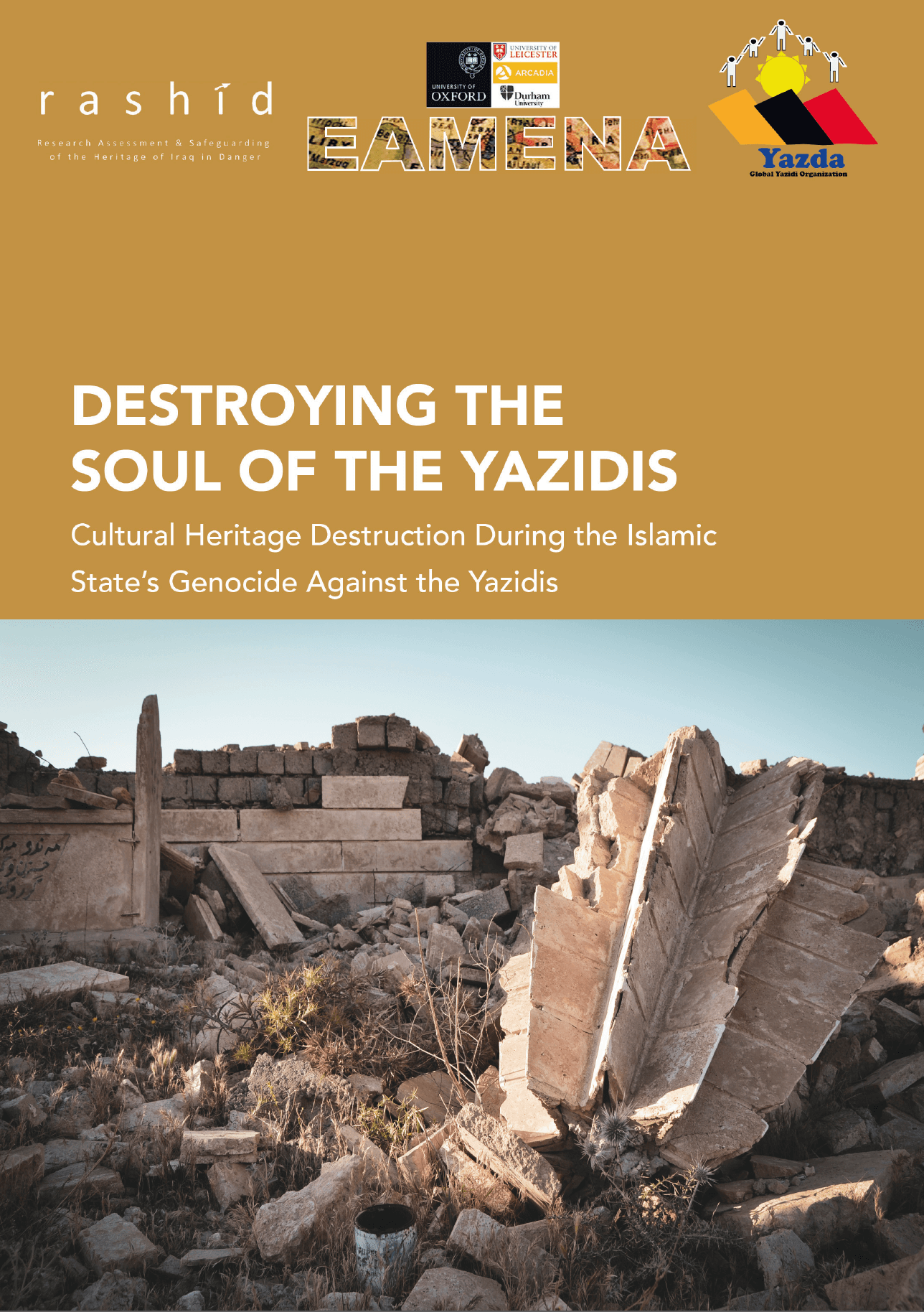Published by: Yazda, EAMENA, RASHID International
Date of publication: August, 2019
Keywords: Cultural heritage | Destruction | Accountability
Citation: "Destroying the Soul of the Yazidis: Cultural Heritage Destruction During the Islamic State’s Genocide Against the Yazidis." Yazda. August 2019.
Discussions of the genocide committed against the Yazidi people by the Islamic State (IS) from 2014 onwards have generally focused on murder, slavery and sexual exploitation. In this report we analyze the destructionof Yazidi tangible and intangible cultural heritage as a significant facet of the Islamic State’s policy of ethnic cleansing and genocide. Evidence of destruction is collected and presented in context with other criminal acts. We present the results of our investigation to the international community in order for these deeds to not go unacknowledged and unpunished.
Section 1
Introduces the Yazidi (Êzidî being the preferred term) people and their strong connection to their cultural heritage. The Yazidis are an endogamous community at home in northern Iraq for more than 6,500 years, for whom faith and ethnic belonging are inextricably linked. Belief in God and Tawûsê Melek (the highest angel), and reverence for Lalish as the holiest place on earth are the defining features of the Yazidi faith. Nature and seasonal changes feature prominently. Historic and sacred places are an essential part of the Yazidi identity and are considered vital to life by the local population. The destruction of Yazidi cultural heritage significantly threatens the survival of the community.
Section 2
Provides an overview of the genocide against the Yazidis. The Islamic State made no secret of its intention to eradicate the Yazidi community and commenced a coldly calculated policy of ethnic cleansing and genocide on 3 August 2014. All victims were abused and tortured. Male Yazidis above the age of 12 were killed. Female Yazidis were enslaved and traded in a complex and public network of sexual slavery. Those who fled to Mount Sinjar were besieged in order to ensure death from starvation, thirst and the blazing sun. Bases of economic support, such as olive groves and irrigation wells, were systematically destroyed and many areas of the Yazidi homeland were sown with landmines and improvised explosive devices (IEDs) to prevent the population from returning.
Section 3
Analyzes the relevant framework of international criminal law. It focuses on crimes contained in the Rome Statute of the International Criminal Court (ICC), but customary international law is substantially the same and applicable to all States in the world. The destruction of tangible cultural heritage is most easily prosecuted as a war crime, which only requires showing an attack (or destruction under customary law) against a protected site without military justification. Several convictions were obtained before the ICTY, as well as one conviction (Al-Mahdi) and one indictment (Ag Mahmoud) before the ICC.
Attacks against tangible heritage may also be prosecuted as the crime of persecution, a crime against humanity, as part of a widespread or systematic attack on a civilian population. Numerous indictments and convictions before the International Criminal Tribunal for the Former Yugoslavia (ICTY) and other courts attest to the viability of this approach. Finally, destruction of tangible heritage also serves as evidence of the special intent to destroy (dolus specialis) a protected group as part of the crime of genocide. The International Court of Justice (ICJ), the ICTY and German national courts all accept the value of heritage destruction as evidence of intent to commit genocide. Matters of jurisdiction and possible for prosecuting Islamic State fighters are explained. Report on Cultural Heritage Sites in the Bahzani and Sinjar Areas.
Section 4
Provides original research, evidence and context on the destruction of Yazidi tangible cultural heritage in the Bahzani/Bashiqa and Sinjar areas of northern Iraq. We present satellite imagery analysis conducted by the EAMENA project, drawing on data provided by Yazidi representatives. According to the Department of Yazidi Affairs in the Ministry of Awqaf and Religious Affairs in the Kurdistan Regional Government 68 Yazidi sites were destroyed by IS. We consider 16 sites in the Bahzani/Bashiqa area and 8 in the Sinjar area to which access was possible and which could be documented.
Section 5
Offers conclusions and recommendations. We conclude that the destruction of the cultural heritage of the Yazidi people constitutes a war crime, a crime against humanity (persecution) and further evidence of genocide. We recommend that the ICC and national prosecutors open investigations wherever jurisdiction allows. We further recommend the consideration of cultural heritage destruction in any prosecution of international crimes, especially the crime of genocide. Adding Lalish Temple and its surroundings to the World Heritage List and the List of Cultural Property under Enhanced Protection should be a priority. We urge the international community to assist with the reconstruction of Sinjar and Bahzani/Bashiqa to prevent Yazidi culture from being lost forever.
For full publication
click here.
We look forward to receiving your inquiries at media@yazda.org

